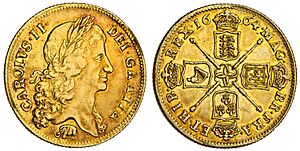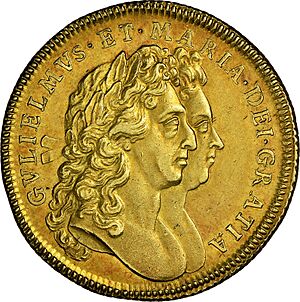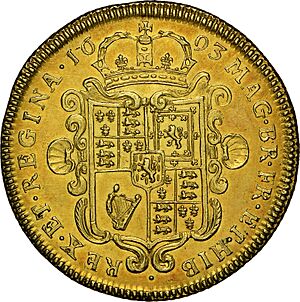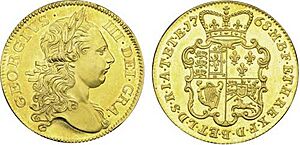Two guineas (British coin) facts for kids
The two guinea piece was a special gold coin first made in England in 1664. It was worth 40 shillings. The coin got its name, "guinea," from the region in West Africa where the gold came from. Early coins sometimes had a small elephant or castle symbol. This showed the gold was supplied by the Royal African Company. For most of its history, the coin weighed about 16.7 to 16.8 grams. It was also about 31-32 millimeters wide.
The Two guinea coin was made in several years, including 1664, 1665, 1669, 1673, and from 1675 to 1684. The front and back of the coin were designed by John Roettiers. The front showed King Charles II facing right, wearing a laurel wreath. Around him, it said CAROLVS II DEI GRATIA, which means "Charles II, by the Grace of God."
The back of the coin had four crowned shields. These shields showed the symbols of England, Scotland, France, and Ireland. Between the shields were four sceptres, which are royal staffs. In the middle, there were four "C"s linked together. The inscription around them said MAG BR FRA ET HIB REX [date], meaning "King of Great Britain, France, and Ireland." The coin was too thin for writing on its edge. But it had a special milled (grooved) edge. This helped stop people from cutting off bits of gold or trying to make fake coins from silver. Until 1668, the grooves were straight up and down. After 1669, they were slanted.
Contents
James II's Two Guineas
John Roettiers also designed the coins during the reign of King James II. These coins weighed about 16.7 grams. They were only made in 1687 and 1688. By this time, the value of a guinea had gone up to almost 30 shillings. On these coins, the king's head faces left. The words around him say IACOBUS II DEI GRATIA. The back of the coin was similar to Charles II's. But it did not have the linked "C"s in the middle. The edge of these coins also had slanted grooves.
William and Mary's Two Guineas
After James II was removed in the Glorious Revolution of 1688, his daughter Mary and her husband Prince William of Orange ruled together. Their heads appear joined on the two guinea piece, like in Roman style. William's head was on top. The words around them said GVLIELMVS ET MARIA DEI GRATIA.
The back of the coin was a new design. It had a large crowned shield. This shield showed the symbols of France, Scotland, Ireland, and England. In the very center was a small shield with the lion of Nassau. The words on the back said MAG BR FR ET HIB REX ET REGINA date, meaning "King and Queen of Great Britain, France, and Ireland." These coins weighed between 16.7 and 16.8 grams. They were mostly made in 1693 and 1694.
William III's Two Guineas
After Queen Mary died in 1694, William continued to rule alone as William III. The Two guinea coin was only made in 1701 during his solo reign. The design was likely made by Johann Crocker, also known as John Croker.
The coins of William III weighed 16.7 grams. William's head faces right on his coins. The words around him say GVLIELMVS III DEI GRATIA. The design on the back of the coin went back to how it was for Charles II and James II. But it still had a small shield with the lion of Nassau in the middle. The words on the back said MAG BR FRA ET HIB REX date. The edge of the coin had slanted grooves.
Queen Anne's Two Guineas
Queen Anne ruled from 1702 to 1714. No two guinea coins were made until after England and Scotland joined together in 1707. Coins were then made in 1709, 1711, 1713, and 1714. The front of the coin showed Queen Anne facing left. The words around her said ANNA DEI GRATIA.
The back of the coin was similar to the previous reign. It had four crowned shields with sceptres between them. The symbols of England and Scotland were now joined on one shield. The order of the shields became England and Scotland, France, England and Scotland again, and Ireland. In the center of the back design was the Star of the Order of the Garter. The edge of the coin had slanted grooves.
George I's Two Guineas
During the reign of George I, the value of the Guinea was officially changed in 1717 to 21 shillings. This meant the Two-Guineas coin was now worth 42 shillings. Because its value had changed a lot over the years, Two-Guineas coins were not made very often. They were only made in 1717, 1720, and 1726.
The coins showed the new Hanoverian family's titles. The front had a portrait of the king facing right. The words around him said GEORGIVS D G M BR FR ET HIB REX F D. The back followed the same general design. But the order of the shields was England and Scotland, France, Ireland, and Hanover. The words on the back were BRVN ET L DVX S R I A TH ET EL date. This means "Duke of Brunswick and Luneburg, Arch-Treasurer and Elector of the Holy Roman Empire." The edge of the coin had slanted grooves. These coins weighed 16.8 grams.
George II's Two Guineas
The Two guinea pieces made during George II's reign were the last ones made for regular use. They were made in 1734, 1735, 1738–1740, 1748, and the very last in 1753. These coins weighed 16.8 grams. At first, the edge of the coin had slanted grooves. But from 1739, the grooves were changed to a chevron or arrow-head shape. This was done to stop people who were illegally filing down the coins to steal gold.
The front of the coin had a bust of the king facing left. The words around him said GEORGIVS II DEI GRATIA. The back had one large crowned shield. It showed the symbols of England and Scotland, France, Hanover, and Ireland. The words on the back were M B F ET H REX F D B ET L D S R I A T ET E. This means "King of Great Britain, France and Ireland, Defender of the Faith, Duke of Brunswick and Luneburg, Arch-Treasurer and Elector of the Holy Roman Empire."
Special "pattern" or "proof" Two Guinea coins were also made during George II's reign. These were made with great care and highly polished. They were like test coins. For example, a pattern Two Guinea coin from 1733, made by John Croker, was sold for £38,000 at an auction.
George III (1760–1820)
No Two Guinea coins were made for regular use during George III's reign. However, the Royal Mint still made special "proofs" and "patterns." These were trial coins made to see how future coins might look. The main engraver, John Sigismund Tanner, made trial coins in 1768, 1770, and 1773. Later, his assistant Richard Yeo made a trial coin in 1777. Only a few of these were made, so they are now very rare and valuable to collectors. A 1768 Pattern Two Guinea coin holds the record for the highest price paid for this type of coin. It sold for over £120,000 in 2014.





